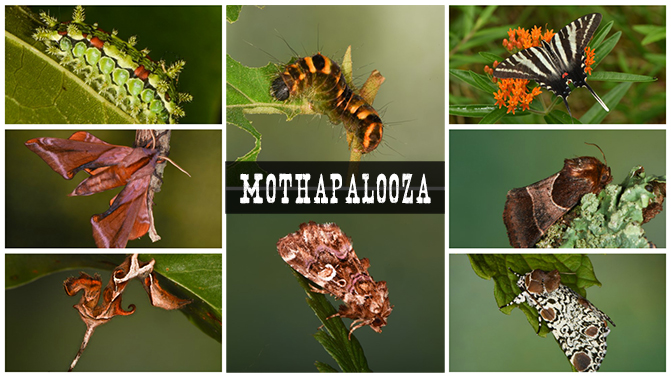


Mothapalooza
Illustration by Christy Mannering September 13, 2016
UD professor stresses importance of helping moths, a key component in food webs
Late at night, neighbors of the University of Delaware’s Doug Tallamy might notice a mercury vapor lamp glowing in his back yard and the unusual sight of a bedsheet draped over a rope hanging from a tree, the purpose of which is to attract moths in order to catalog them.
Much like birding, mothing has taken off across the United States as a hobby for enthusiasts and in order to expose students interested in entomology to the many aspects of mothing and the many interesting qualities of moths, Tallamy took a group of four undergraduates to the most recent Mothapalooza, held in early August at the Shawnee Lodge and Conference Center in West Portsmouth, Ohio.
The students who went on the trip were Erik Wright and Magdalen Cattle, both juniors in the College of Agriculture and Natural Resources (CANR), William Keilsohn, a senior in the College of Earth, Ocean, and Environment (CEOE); and Lindsay Cathcart, a sophomore in CANR.
Started four years ago by Dave Wagner, a faculty member in the University of Connecticut’s Department of Ecology and Evolutionary Biology, and Jim McCormac, who works with Ohio Fish and Game, Mothapalooza is a public event at which participants look for and photograph moths. The event features caterpillar hunting by day, and moth lights run by night at five different locations with buses that shuttle participants around and about until as late as 2 a.m.
Tallamy discovered the event when he was brought in last year as a speaker.
“Running moth lights and recording what you see has caught on the way bird listing has; everybody wants to see the birds and check them off. It’s much harder with moths because there are 12,500 identified, named moths in North America and probably another 1,500 unnamed ones,” said Tallamy.
Tallamy said that it was great to expose the students to such a specialized group of insect lovers and to the insects themselves, and conceded that mothing is not for everybody, as he himself only picked up the hobby a few years ago.
“I’ve been here for 35 years and I’ve been an entomologist for a good 10 years before that, and I didn’t get into running moth lights until maybe three or four years ago for a couple of reasons. I don’t like staying up late. I really like my sleep. Another reason is that when I started working with trophic levels — plants, herbivores, predators — and how our landscaping practices impacts food webs, I focused on caterpillars, the larvae of moths, not on the adults. So now I do both. The caterpillars are really cool but so are the adults,” said Tallamy.
In order to do mothing the correct way, Tallamy said that those aspiring to see moths need to be up all night, as different species arrive at the sheet in his yard at different times. An old mothing adage claims that the really good species come after midnight, which Tallamy said is correct.
“Usually early on, there’s not too much happening, and then, of course, it changes. Every week you get new species coming in, so it’s hard to run a light without getting something you didn’t see the last time,” said Tallamy.
For his own backyard project, Tallamy has a goal of seeing how many species of moths are sustained by his property in order to “put his money where his mouth is,” so to speak, when referencing the importance of native plants to ecosystems, which is his area of expertise.
“I always talk about how you can generate all this life with proper landscaping, and every one of these species is bird food, and you do it all with the plants in your yard, but if I measure that and say, ‘I actually have over 1,000 species of moths in my yard,’ that means something to somebody. And there are a lot of species. It turns out to be a huge job so it’ll be a couple years before I finish that. Every time I run a moth light at home, I get about 25 new species,” said Tallamy, who put the estimated number of moths he has catalogued at around 700.
As to why mothing has taken off in recent years, Tallamy credits authors such as Seabrooke Leckie, who wrote the Peterson Field Guide to Moths of Northeastern North America, and Wagner, who wrote the guide to Caterpillars of Eastern North America, for making the field user friendly.
“Knowledge generates interest and interest generates compassion, so we start with knowledge. What are these things? We humans have to put a name on something, otherwise it doesn’t mean anything to us. The ability to identify moths, both as adults and as caterpillars, has really opened up this giant level of biology to the general public, and they love it. It really was just a matter of making it user friendly,” said Tallamy.
This newfound interest in moths is heartening for Tallamy because in addition to being cool to look at, he said moths are the most important component of terrestrial food webs.
“There are 19 species of moths for every species of butterfly. They’re really driving the food system, so even if you hate them or don’t want to look at them on a light sheet and don’t know what their names are, they’re critical in all of our terrestrial habitats. If you’re going to be a good steward of this planet, you need to be making moths at home. Ethically this is why we should be looking at these things,” said Tallamy.
Contact Us
Have a UDaily story idea?
Contact us at ocm@udel.edu
Members of the press
Contact us at 302-831-NEWS or visit the Media Relations website

